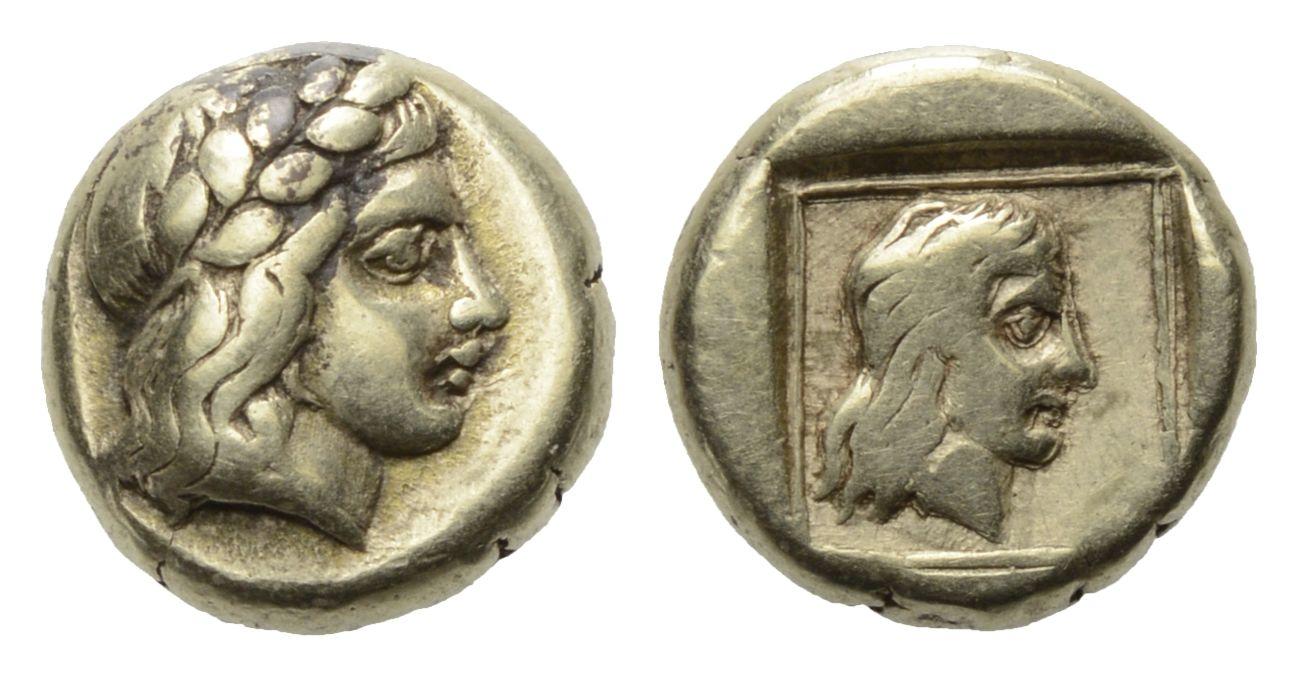AC 214 - Mytilene, electrum, hekte, 412-378 BC
From SILVER
412 BCE - 378 BCE Electrum 37,985 kg
Description
| ObverseInscription or printing placed on the obverse.: | Head of Apollo with laurel wreath right. |
| ReverseInscription or printing placed on the reverse.: | Female head with long hair, the whole in line square and recessed square. |
Mint and issuing power
| MintIdentifies the place of manufacture or issue of a numismatic object.: | Mytilene | Ancient regionAncient region.: | Aeolis (islands) | Modern countryModern country: Greece | AuthorityIdentifies the issuing power. The authority can be "pretended" when the name or the portrait of X is on the coin but he/she was not the issuing power. It can also be "uncertain" when there is no mention of X on the coin but he/she was the issuing power according to the historical sources: |
Chronology
| FromIdentifies the initial date in a range assigned in a numismatic context. | 412 BCE | toIdentifies the final date in a range assigned in a numismatic context.. | 378 BCE | PeriodTime period of the numismatic object.: Classical 480-323 BC |
Physical description
| MetalThe physical material (usually metal) from which an object is made.: | Electrum http://nomisma.org/id/el | Median weightMedian of the weights of numismatic objects (in grams). in grams | 2.50 | DenominationTerm indicating the value of a numismatic object. Examples: tetradrachm, chalkous, denarius.: | hekte |
StandardStandard.: |
Image

AC214 Mytilene.jpeg [1]
References
Obverse dies distribution
| FrequencyFrequency of specimen in distribution. ᵖ | Number of obversesNumber of obverse dies. ᵖ (o) | % (o) | Number of coinsNumber of coins. (n) | % (n) | Die nameName(s) of the die(s). |
| 1 | 9 | 13.43 | 9 | 2.98 | 62a, 63a, 63b, 63f, 67b, 77a1, 78a, 78b, 79c |
| 2 | 8 | 11.94 | 16 | 5.3 | 66a, 71a, 75a, 75d, 77b, 77e, 78d, 78e |
| 3 | 6 | 8.96 | 18 | 5.96 | 63g, 65c, 70c, 71c, 77f, 77h |
| 4 | 15 | 22.39 | 60 | 19.87 | 61a, 64a, 65a, 65e, 65g, 67a, 70b, 73a, 73b, 73e, 73f, 74a, 75e, 78c, 79d |
| 5 | 7 | 10.45 | 35 | 11.59 | 65b, 65h, 69c, 70a, 73g, 76a, 77d |
| 6 | 7 | 10.45 | 42 | 13.91 | 63e, 65d, 68a, 69a, 70e, 72a, 73d |
| 7 | 8 | 11.94 | 56 | 18.54 | 63c, 65f, 69b, 70d, 73c, 77c, 77g, 79a |
| 8 | 2 | 2.99 | 16 | 5.3 | 63d, 71b |
| 10 | 1 | 1.49 | 10 | 3.31 | 74b |
| 13 | 1 | 1.49 | 13 | 4.3 | 75b |
| Total | 64 of 67 | 95.53 | 275 of 302 | 91.06 |
Reverse dies distribution
no distribution is available
Quantification
| Number of obversesNumber of obverse dies. ᵖ (o) | 67 | Number of singletons (o1)The number of singleton coins. ᵖ | 9 |
| Number of reverse diesNumber of reverse dies. (r) | Number of coinsNumber of coins. (n) | 302 | |
| Coins per obverse dieNumber of coins per obverse die. (n/o) | 4.51 | Coins per reverse dieNumber of coins per reverse die. (n/r) | |
| Reverse per obverse ratioRatio of obverse dies divided by reverse dies. (r/o) | Percentage of singletons (o1)number of coins (n) divided by the number of singletons (o1) ᵖ | 13.43 % | |
| Original number of dies (O) (Carter 1983 formula)The estimation of the number of coins according to Carter 1983 ᵖ | 75.97 | Coins struck if 20,000 as average productivity per dieCoins made if the average productivity for obverses (according to Carter) is 20,000. ᵖ | 1,519,400 |
| Original number of dies (O) (Esty 2011 formula)The estimation of the number of coins according to the singleton formula in Esty 2011 ᵖ (O) | 86.1 | Survival rate if 20,000 as average productivity per dieSurvival rate if average productivity is 20,000. ᵖ | 0.00020 |
| Coverage (o = % of O) (Esty 1984 formula)Esty 1984 - coverage (% of O) ᵖ (o = % of O) | 97.02% | Die productivity if survival rate 1/2,000Average productivity if survival rate is 1/2,000. ᵖ | 7,950.51 |
| Weight of silver (in kg) if 20,000 coins per die (O = Carter formula)Carter 1983 * Median weight * 20000 (*10 if gold or electrum) ᵖ | 37,985 kg <br /> 37,985 kg | Die productivity if survival rate 1/5,000Average productivity if survival rate is 1/5,000. ᵖ | 19,876.27 |
Remarks